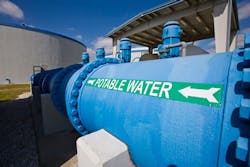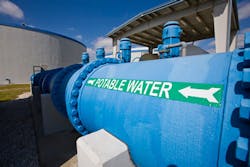High-performance protective coatings are used to prevent corrosion and damage to tank and pipe interiors and exteriors. What are the latest developments?
By Alan J. Cain
In recent years, the many benefits of polyurethane and polyurea systems have made them attractive as alternatives to traditional epoxy and acrylic systems. UV-resistant aliphatic formulations provide long-lasting exterior or aboveground protection, while aromatic formulations provide superior corrosion protection for below ground installations for both interior and exterior surfaces. Both offer rapid return to service for OEMs looking to increase efficiency and productivity.
For both interior and exterior applications, it is also important that the coatings selected be flexible enough to withstand expansion and contraction. Steel water tanks often include joints and seams that are designed for movement in response to changes in the environment. The coatings used to protect these surfaces must have sufficient flexibility to match the level of movement that is expected.
In addition, coatings used for the protection of steel in these challenging conditions must meet increasingly stringent environmental regulations, particularly with respect to the volatile organic compound (VOC) content. Most technologies in use today are either water-based or 100% solids systems. Fast setting systems (polyureas and polyurethanes) used in OEM facilities are 100% solids, zero VOC, and plasticizer- and extender-free.
Conventional Systems
The majority of epoxy systems currently used in the market are between 55% and 70% solids and contain flammable solvents. The greater majority of fast setting polyurethane and polyureas are 100% solids and contain zero flammable solvents.
Typically two or three layers of epoxy are applied, one of which may be a zinc-rich epoxy primer. In recent years, polyurethane elastomers have been increasingly used for protection of the interiors of potable water tanks and pipe externals due to their rapid cure, greater flexibility, and ability to act as a barrier against moisture, chemical attack and ice damage.
Epoxies have also often been used as primer layers on the exteriors of water tanks and pipe due to their excellent adhesion and resistance to water and chemicals. Waterborne acrylic coatings have been widely used as the topcoat in protection systems for water tank exteriors due to their ease of use and lower cost. They tend to be reasonably durable, flexible, and resistant to moisture, chemicals, and UV degradation, although limited by their film build.
High solids polyurethanes and polyureas are higher-performance, longer-lasting coatings (>30-year service life) that can be formulated with a wide range of flexibilities.
Polysiloxanes and fluorinated polyurethanes have also been developed as topcoats for the exteriors of potable water storage tanks. These advanced coatings also have long service lives (~30 years), which means longer intervals between coating removal and replacement, but they may not be zero-VOC and are more expensive, thus the overall cost-benefit must be considered.
Why use 100% solids coatings?
The majority of fast-set polyurethane and polyurea elastomers are 100% solids coatings that cure very rapidly and adhere strongly to steel. Other substrates can be coated, but may require a primer. Because of the unique chemistry of these ultra-high solids systems, they can be formulated to the desired level of flexibility needed to withstand the movement associated with steel tanks and pipes.
With the appropriate choice of starting materials, it is also possible to formulate both polyurethane and polyurea systems with curing times that allow for the application of perfectly smooth, high-build coatings. Importantly, 100% solids polyurethanes and polyureas used for OEM potable water tank coatings and linings cure much more rapidly than epoxies - typically within minutes to hours, rather than days - and will cure below 50 degrees F.
Aromatic Or Aliphatic
Both aromatic and aliphatic systems for potable water pipe and tank applications cure rapidly and provide excellent, long-term corrosion protection. Both can be used for exterior and interior applications, however aliphatic systems generally find use for the coating of the exterior surfaces of water tanks and aboveground pipes, while aromatic systems are preferred for interior protection and underground applications. What is the difference?
Aromatics have chemical bonds in them that absorb UV radiation, which leads to undesirable yellowing of these coatings over time. Aliphatics do not possess this bond and therefore are not affected by UV radiation. Their color, gloss, and other appearance characteristics are retained for extended periods, even when exposed to sunlight.
Aliphatic polyurea and polyurethane coatings are more expensive, however. One solution to this issue is to use a thick aromatic basecoat with a thinner aliphatic topcoat to reduce overall cost.
In addition, polyaspartic coatings go on thinner than regular aliphatic polyureas, but thicker than traditional solventborne aliphatic polyurethanes, making them suitable for high-performance topcoats. Like regular polyureas, there fast cure time makes them ideal for OEM potable water tank and pipe manufacturing, where a rapid turnaround time equates to higher productivity and greater profits.
For the interiors of potable water storage tanks and the exterior and interior of belowground piping, since UV exposure isn’t a concern, there is no need for aliphatic chemistry in these applications. Aromatic systems provide long-term protection combined with quick return to service.
Alan J. Cain is group leader/research chemist at Chemline, Inc.
More Water & WasteWater International Archives Issue Articles




